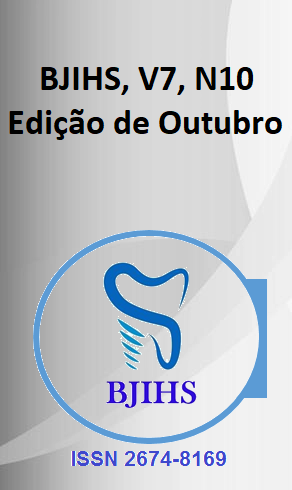Abstract
Introduction: The extraction of lower third molars (3MI) is one of the most commonly performed surgical procedures in the clinical routine of dental surgeons. However, there is a complication commonly associated with the removal of these teeth, namely injury to the inferior alveolar nerve (IAN), which occurs due to the proximity of the roots of these teeth to the IAN. Predicting the proximity of the IAN to the roots of the impacted lower third molar can greatly reduce the complications arising from the removal of these teeth. It is quite common during pre-surgical planning to request imaging exams such as digital panoramic radiography (DPR), which constantly shows overlaps of the roots of lower third molars on the mandibular canal, and cone beam computed tomography (CBCT) in more complex cases. Objectives: The general objective of this study is to comparatively analyze the degree of accuracy in the topographic analysis of digital panoramic radiography and cone beam computed tomography in relation to the roots of the lower third molars and the inferior alveolar nerve. Methodology: This is a qualitative cross-sectional exploratory field study in which panoramic radiographic examinations and CBCT scans were selected from 100 patients at a private radiology clinic in the city of Imperatriz, Maranhão, Brazil. Conclusion: Thus, DPR proved to be efficient in initial surgical planning, but CBCT was necessary in more complex cases due to its three-dimensional characteristics. Among the results obtained, the most evident radiographic sign in RPD is the interruption of the radiopaque line of the mandibular canal, followed by darkening of the roots, which are the most suggestive of intimacy with the mandibular canal.
References
GUILLEN, Gabriel Albuquerque. Comparação entre o grau de precisão da radiografia panorâmica digital e da tomografia computadorizada de feixe cônico na análise da topografia das raízes de terceiros molares inferiores e do canal mandibular. 2015. Trabalho de Conclusão de Curso (Graduação em Odontologia) – Faculdade de Ciências da Saúde, Universidade de Brasília, Brasília, 2015.
FONSECA, Ana Luiza Fernandes Botrel. Radiologia odontológica: avaliação dos sinais radiográficos de terceiros molares inferiores. 2025. 80 f. Monografia (Especialização em Radiologia Odontológica) – Faculdade X, Belo Horizonte, 2025.
RIBEIRO, E. C. et al. Análise radiográfica e tomográfica da íntima relação dos terceiros molares inferiores com o canal mandibular. Arquivos em Odontologia, Belo Horizonte, v. 52, n. 4, p. 197–206, out./dez. 2016.
ANTUNES, Hugo. Complicações associadas à extração de terceiros molares inclusos. Dissertação (mestrado em medicina dentária) – Universidade Fernando Pessoa, Porto, 2014.
SEGURO, Daiana; Oliveira, Renato. Complicações pós-cirurgicas na remoção de terceiros inclusos. Revista UNINGÁ Review, v.20, n.1, p.30-34, out./dez. 2014.
PESSOA, et al. Fratura de mandíbula relacionada à exodontia de terceiro molar: relato de caso.RevOdontol UNESP. (“Exodontia de Terceiro Molar - Anatomia e Escultura Dental”) 2019; 48(N Especial):101
ALMEIDA, C. C. Parestesia – como conduzir na prática odontológica? 2022. Trabalho de Conclusão de Curso (Graduação em Odontologia) – Centro Universitário Sagrado Coração – UNISAGRADO, Bauru, 2022. (“Repositório - UNISAGRADO: A IMPORTANCIA DA ODONTOLOGIA HOSPITALAR ...”)
PROFFIT, et al. Ortodontia contemporânea. 4ª ed. Rio de Janeiro: ELSEVIER, 2007.
NEVES, F. S. et al. Avaliação da relação entre o canal mandibular e os terceiros molares inferiores por meio de radiografias panorâmicas. Revista de Odontologia da UNESP, Araraquara, v. 41, n. 2, p. 83–88, 2012.
ATIEH, M. A. Diagnostic accuracy of panoramic radiography in determining relationship between inferior alveolar nerve and mandibular third molar. Journal of Oral and Maxillofacial Surgery, v. 68, n. 1, p. 74-82, 2010.
GHAEMINIA, H. et al. Posição do terceiro molar incluso em relação ao canal mandibular: acurácia diagnóstica da tomografia computadorizada de feixe cônico comparada à radiografia panorâmica. International Journal of Oral and Maxillofacial Surgery, [S.l.], v. 38, n. 9, p. 964–971, set. 2009.
MATZEN, L. H. et al. Reprodutibilidade da avaliação de terceiros molares inferiores comparando duas unidades de tomografia computadorizada de feixe cônico em um modelo de pares emparelhados. Dentomaxillofacial Radiology, [S.l.], v. 42, n. 10, p. 20130228, set. 2013.
FELEZ GUTIÉRREZ, J.; ROCA PIQUÉ, L.; BERINI AYTÉS, L.; GAY ESCODA, C. Las lesiones del nervio dentario inferior en el tratamiento quirúrgico del tercer molar inferior retenido: aspectos radiológicos, pronósticos y preventivos. Archivos de Odontoestomatología, v. 13, n. 2, p. 73–83, fev. 1997
XAVIER, C. R. G. et al. Avaliação das posições dos terceiros molares impactados de acordo com as classificações de Winter e Pell & Gregory em radiografias panorâmicas. Revista de Cirurgia e Traumatologia Buco-Maxilo-Facial, Camaragibe, v. 10, n. 2, p. 83–90, abr./jun. 2010.
PALMA-CARRIÓ, C.; GARCÍA-MIRA, B.; LARRAZABAL-MORÓN, C.; PEÑARROCHA-DIAGO, M. Sinais radiográficos associados à lesão do nervo alveolar inferior após extração de terceiros molares inferiores. Dento-Maxillo-Facial Radiology, [S.l.], v. 15, n. 6, p. e886–e890, 2010.
MARTINS NETO, Roque Soares; MACHADO, Arthur Lima; BARBOSA NETO, Luiz Alves; ALVES, Ivna Freitas de Sousa; ESSES, Diego Felipe Siveira; LOPES, Kelvin Saldanha. "Relação entre terceiros molares inferiores e canal mandibular com o surgimento de lesões pós-operatórias ao nervo alveolar inferior." (“CORONECTOMIA EM TERCEIROS MOLARES INFERIORES NA ... - MASTER EDITORA”) Brazilian Journal of Surgery and Clinical Research – BJSCR, v. 24 , n. 1, p 66-71, 2018.
NUNES, Willy James Porto. Confiabilidade dos sinais radiográficos preditivos de proximidade entre o terceiro molar inferior e canal da mandíbula em radiografia panorâmica: estudo comparativo com tomografia computadorizada de feixe cônico. 2018. Trabalho de conclusão de curso – Universidade Federal de Juiz de Fora – Campus avançado Governador Valares, Juiz de Fora, 2018.

This work is licensed under a Creative Commons Attribution 4.0 International License.
Copyright (c) 2025 Ana Clara Silva Sousa, Andressa Lima Dos Santos , Henrique Steinhauser
